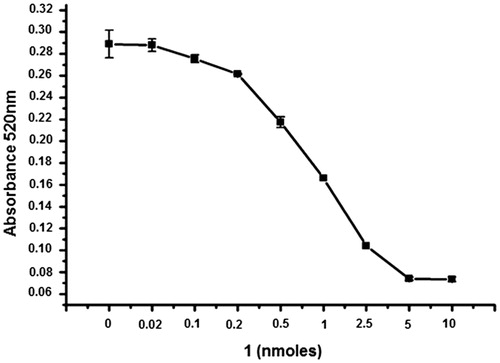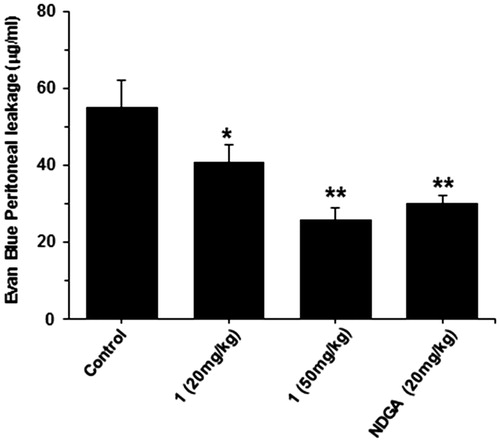Abstract
Human lipoxygenases (LOXs) have been emerging as effective therapeutic targets for inflammatory diseases. In this study, we found that four natural 2-arylbenzo[b]furan derivatives isolated from Artocarpus heterophyllus exhibited potent inhibitory activities against human LOXs, including moracin C (1), artoindonesianin B-1 (2), moracin D (3), moracin M (4). In our in vitro experiments, compound 1 was identified as the most potent LOX inhibitor and the moderate subtype selective inhibitor of 12-LOX. Compounds 1 and 2 act as competitive inhibitors of LOXs. Moreover, 1 significantly inhibits LTB4 production and chemotactic capacity of neutrophils, and is capable of protecting vascular barrier from plasma leakage in vivo. In addition, the preliminary structure–activity relationship analysis was performed based on the above four naturally occurring (1–4) and six additional synthetic 2-arylbenzo[b]furan derivatives. Taken together, these 2-arylbenzo[b]furan derivatives, as LOXs inhibitors, could represent valuable leads for the future development of therapeutic agents for inflammatory diseases.
Introduction
Lipoxygenases (LOXs) comprise a family of lipid-peroxidizing enzymes that catalyze the insertion of oxygen to polyunsaturated fatty acids containing a cis, cis-1,4-pentadiene structureCitation1. The most well-known members have been designated as 5-LOX, 12-LOX and 15-LOX, according to the number indicating at which carbon the oxygen is introducedCitation2,Citation3. The LOX enzymes can catalyze arachidonic acid (AA) into individual hydroperoxy-eicosatetraenoic acids (HPETEs) and their corresponding hydroxyeicosatetraenoic acids (HETEs). In the case of 5-LOX, 5-HPETE is progressed to the unstable epoxide leukotriene A4 (LTA4) enzymaticallyCitation4, which in turn is converted to LTB4 or LTC4 by leukotriene A4 hydrolase (LTA4 hydrolase) and leukotriene C4 synthase (LTC4 synthase), respectivelyCitation5. Leukotrienes (LTs) are one of the potent eicosanoid lipid mediators and function as initiators of leukocyte recruitmentCitation6. Also, LTs have vasomotor properties which is associated with cardiovascular, renal, pulmonary and cutaneous manifestationsCitation7,Citation8. In all isoforms of LOXs, 12-LOX play a unique demonstrated role in skin diseases, diabetes, platelet hemostasis, thrombosis and cancerCitation9. In mammalians, the crucial role of the 15-LOX and its metabolic products, hydroxyoctadecadienoic acid (HODE), lipoxins and eoxins, in the progress of inflammation, sensitivities and atherosclerosis has also been demonstratedCitation10. Hence, LOXs have been emerging as effective therapeutic targets for many diseasesCitation11.
To date, abundant natural and synthetic inhibitors of LOXs have been reportedCitation12–18. The 5-LOX inhibitor, zileuton, have been approved by Food and Drug Administration for the treatment of asthma regardless of its paradox in clinical efficacyCitation14. The most promising 12-LOX inhibitors so far are baicalein and N-benzyl-N-hydroxy-5-phenylpentamide (BHPP), and they have been confirmed to induce apoptosis and control the cell cycle in human cancersCitation15–17. Several 15-LOX inhibitors such as 1, 3, 4-oxadiazole-, trytamine- and imidazole-based derivatives have shown selectivity against both 5-LOX and 12-LOX. However, none of the 12-LOX and 15-LOX inhibitors have been used for clinical application yetCitation18–20. In the view of the fact that almost all of the LOXs inhibitors have deficiencies in clinical use more or less, there is an urgent demand for the development of novel effective LOXs inhibitors as therapeutic medication.
Artocarpus heterophyllus, one of the 50 species of genus Artocarpus (Moraceae) among evergreen and deciduous trees, have been considered as economic sources of food and largely used in traditional medicineCitation21. It has been reported that abundant phenolic compounds including flavonoids, stilbenoids and 2-arylbenzo[b]furans isolated from A. heterophyllus exhibited extensive pharmacological activities including anti-inflammatory, antioxidant, antiplatelet and antiviral activitiesCitation21,Citation22. Notably, 2-arylbenzo[b]furan structureCitation23, which is prevalent in a wide range of biological active natural and unnatural compoundsCitation24 and its derivatives are well-known to display the most common biological functions including anticancerCitation25, anti-inflammatoryCitation26, antiviralCitation27 and antioxidativeCitation28 to prevent the body from injuries. In a previous work, we present the synthetic methodology of three 2-arylbenzo[b]furan derivatives 1, 2 and 4 from A. heterophyllusCitation29. In the present study, the inhibition activity and mode of four natural 2-arylbenzo[b]furan derivatives (1–4) and six synthetic 2-arylbenzo[b]furan derivatives (5–10) on human 5-, 12-, 15-LOX were systematically investigated. We also presented the primary structure–activity relationship (SAR) analysis of 2-arylbenzo[b]furan derivatives on LOXs. The lead compound 1 significantly inhibits LTB4 production in neutrophils and reduces fMLP-triggered neutrophil migration. Our work highlights the potential of 2-arylbenzo[b]furan derivatives as LOX inhibitors to be considered as potent lead compounds for the treatment of inflammatory diseases.
Materials and methods
Chemistry
Natural products 1–4 (purity> 95%) isolated from A. heterophyllus were purchased from BioBioPha Co., Ltd. (Kunming, China). Six synthetic 2-arylbenzo[b]furan derivatives compounds (5–10) were prepared in our laboratory previouslyCitation29.
LOXs expression and purification
Human LOXs were expressed as N-terminally his-tagged proteins in Escherichia coli and purified by Ni2+-chelate affinity chromatography as previously describedCitation30. Briefly, Rosetta cell containing pet14b-5-LOX plasmid was cultured in Terrific Broth at 37 °C for 4 h and then shifted to 20 °C for an additional 24 h. Cells were harvested for further purification. The cell pellets were resuspended in lysis buffer (50 mM Tris, pH 8.0, 500 mM NaCl, 20 mM imidazole, 100 μM PMSF). The suspension was lysed by sonication and centrifuged at 12 000g for 30 min at 4 °C. The supernatant was then loaded on a Ni-NTA column pre-equilibrated with 50 mM Tris, pH 8.0, 500 mM NaCl, 20 mM imidazole, washed with 50 mM imidazole and eluted with 50 mM Tris, pH 8.0, 500 mM NaCl, 200 mM imidazole. The elution was concentrated using Millipore Amicon Ultra (Millipore Corporation, Bedford, MA) immediately for an enzymatic assay. The pET28a-p-12-LOX and pET28a-15-LOX-1 plasmids were transformed into BL21 (DE3), and expressed and purified similar to the stable-5-LOX.
Dihydrorhodamine 123 (DHR)-based LOXs enzyme activity assay
LOX activities were tested by DHR assay as described previouslyCitation31. DHR is a cell-permeative fluorogenic probe that is used as an indicator of the formation of the intracellular peroxide peroxynitrite peroxyl and hydroxyl radicals. The DHR assay utilizes the ability of LOX-generated lipid hydroperoxides that oxidized nonfluorescent DHR to the highly fluorescent dye rhodamine 123. The formed fluorescent signal can then be monitored at Ex/Em = 500/536 nm. Spodoptera frugiperda (Sf21) insect cell lysates containing active human wide-type 5-LOX were obtained from Cayman Chemical (Ann Arbor, MI). The DHR assay was executed in white 384-well plates and the total volume was 50 μL. Purified 5-LOX (400 nM), 12-LOX (120 nM), 15-LOX (18 nM) or SF21 cell lysates (0.3 U, according to the instruction from Cayman chemical) was diluted in assay buffer (50 mM Tris-HCl, pH 7.4) with a final concentration of 5 μM DHR. The reactions were initiated by the addition of 20 μM AA and the fluorescence intensity was read using Synergy 2 Muti-Mode Microplate Reader (BioTek, Winooski, VT) with the excitation and emission wavelengths of 500 nm and 536 nm, respectively.
Spectrophotometric assay
Recombinant LOX activity assays were performed at room temperature as described previouslyCitation32. The newly generated conjugated diene (HETEs and HpETEs) catalyzed by LOXs can be detected by the absorbance at 234 nm using an ultraviolet-visible spectrophotometer Hitachi U2910 (Tokyo, Japan) (assay buffer: 50 mM Tris-HCl pH 7.5, 0.3 mM CaCl2, 0.1 mM EDTA, 0.1 mM ATP and 40 μM AA). All enzyme reactions were carried out in 1 cm pathlength quartz cuvettes with a total volume of 500 μL, and absorbance at 234 nm was continuously measured for 300 s. To determine the inhibitor type, various concentrations of compounds were used, and the reaction was started by the introduction of AA.
DPPH assay
The antioxidant activity of compound was performed as described previously with minor modificationsCitation33. In brief, 100 μl of 1, 2.5, 5, 10, 25, 50 or 100 μM 1 in ethanol (corresponding to 0.1, 0.25, 0.5, 1, 2.5, 5 or 10 nmoles) was incubated with 100 μl of a solution of the stable free-radical diphenylpicrylhydrazyl (DPPH) in ethanol (100 μM, corresponding to 10 nmoles), adjusted to pH 5.5 with acetate, in a 96-well plate. The absorbance was recorded at 520 nm after 30 min incubation under gentle shaking in the dark at room temperature. All the experiments were performed in triplicates.
Isolation of mouse neutrophils from bone marrow
Female C57BL/6 mice (6–8 weeks) were sacrificed, the femurs and tibias were removed from both hind legs and freed of soft tissue attachments before soaked in the HBSS (without calcium and magnesium) supplemented and 100 U/mL penicillin, 100 U/mL streptomycin. After washing with 75% ethanol once and phosphate buffered saline (PBS) twice, Hank’s Balanced Salt Solution (HBSS) with 2 mM EDTA was forced through the bones with a syringe, and the solution was filtered through a cell strainer. Cells were centrifuged at 1500 rpm for 10 min, the remaining red cells in the neutrophil pellet were eliminated by hypotonic lysis and spun down (1500 rpm, 10 min, 4 °C). Cells were washed once with PBS and resuspended in HBSS, and layered on top of a discontinuous Histopaque gradient containing 3 mL of Histopaque (Sigma-Aldrich) at 1.119 g/mL at the bottom and 3 mL of Histopaque at 1.077 g/mL on top. Cells were centrifuged for 45 min at 1600 rpm without braking. Cells at the interface of the two layers were collected and washed twice with PBS. We obtained ∼1 × 107 living cells per mouse, and 85 ± 1% of them were found to be neutrophils using trypan blue staining and Wright’s staining.
Determination of LTB4 formation
The neutrophils were cultured in RPMI-1640 medium supplemented with 10% fetal bovine serum (GIBCO, Paisley, Scotland) at 2 × 106 cells/mL and incubated with inhibitors at an indicated concentration for 30 min at 37 °C. Cells were stimulated with 10 μM A23187 for another 30 min and supernatants were collected and frozen at −80 °C for the measurement of LTB4 releaseCitation34. LTB4 was measured using an ELISA kit (Cayman Chemical, Ann Arbor, MI). Assays were performed according to the manufacturer’s protocol.
The assay was based on the competition between LTB4 and LTB4-AchE conjugate (LTB4 tracer) for a limited amount of LTB4 antiserum. Briefly, the sample (LTB4 standards) and LTB4 Tracer were allowed to bind to LTB4 antiserum overnight and the plate was washed to remove any unbound reagents. Finally, Ellman’s reagent containing AChE substrate was added to the wells and the amount of AChE Tracer interacted with Ellman’s reagent was monitored at 412 nm. The concentration of LTB4 was inversely proportional to the amount of LTB4 tracer bonded to the LTB4 antiserum.
Transwell migration assay
Neutrophils (2 × 105) from mouse bone marrow were resuspended in 100 μL HBSS (without calcium and magnesium) containing 0.5% bovine serum albumin (BSA) and incubated with compounds at indicated concentrations for 30 min at 37 °C. Cells were placed on the top of a HTS transwell 96-well chemotaxis plate using polycarbonate filters with 3 μm pore diameter (Corning, NY) and allowed to migrate towards indicated concentration of fMLP (5 μM) at 37 °C for 1 hCitation35,Citation36. Migrated Cells were collected and counted by a cell counter (Nexcelom Bioscience, Lawrence, MA).
Acetic acid-induced vascular permeability test
The acetic acid-induced vascular permeability test was performed as described previously with minor modificationsCitation37,Citation38. The 6–8-weeks male ICR mice were randomly divided into five groups (6 mice for each group). Compound 1 (20 mg/kg and 50 mg/kg) and positive control NDGA (20 mg/kg) were administered intraperitoneallyCitation39 and the normal groups were given equal volume of saline. 10 mL/kg body weight of 1% Evans blue solution (Amresco, Solon, OH) was intravenously injected into each mouse 40 min after intraperitoneal administration of the compounds. One hour later, 10 mL/kg body weight of 1.2% acetic acid was intraperitoneally injected and the mice were euthanized by cervical dislocation after 1 h. About 8 mL of saline was injected into the peritoneal cavity, and the washing solutions were collected by plastic pipets and transferred to the Eppendorf tubes. In order to clear the turbidity caused by protein, 1 N NaOH (1:100, volume ratio) was added to each tube and incubated overnight at 4 °C. The concentration of Evans blue in the peritoneal cavity was measured by absorbance at 630 nm. The vascular permeability was represented by the absorbance that leaked into the cavity.
Results and discussion
LOXs enzyme activity inhibition
In our previous studies, we have developed a rapid and sensitive fluorescence-based assay for the measurement of human LOX activityCitation32. This fluorimetric method takes advantage of the ability of LOX-produced lipid hydroperoxides which oxidizes DHR to the highly fluorescent substance rhodamine 123, and this is the first application of DHR to probe the lipid hydroperoxides derived by human LOXs. We primarily evaluated the inhibition capacity of four natural products isolated from A. heterophyllus on LOX (5-LOX, 12-LOX, and 15-LOX) enzyme activity by the DHR methodCitation32. As shown in , all of the four natural products 1–4 showed potent LOX inhibitory activities in the submicromolar to micromolar range (IC50 = 0.21 ± 0.0 1–4.95 ± 1.27 μM). Nordihydroguaiaretic acid (NDGA) was chosen as a positive control. Compound 1 possessed the most potent LOX inhibitory activity and the moderate subtype selectivity for 12-LOX (∼11-fold selectivity versus 5-LOX, ∼6-fold selectivity versus 15-LOX). The moderate selective 12-LOX inhibitors discovered in this work provide novel scaffolds that lay the foundation for uncovering new 12-LOX regulatory mechanisms and further development into therapeutic candidates for disease treatment. The inhibitory activities of compounds against active human wide-type 5-LOX derived from mammalian cell Sf21 were also determined and the results were comparable to that of 5-LOX expressed in E. coli (). Our results on inhibitory activities of LOXs indicated that 1 may serve as an optimal active LOX inhibitor for further studies. Interestingly, four natural products (1–4) harbored 2-arylbenzo[b]furan structure. Six new 2-arylbenzo[b]furan derivatives were synthesized in our previous workCitation29, we also determined the inhibition activities of these analogs, however, none of them exhibited better inhibitory activities against LOXs than compound 1.
Table 1. IC50 values (μM) of inhibitors against human 5, 12, 15-LOXs.
Structure–activity relationship (SAR)
An analysis of the data shown in provides the basis to formulate the SAR. We can find that compound 1 possessed the most potent LOX inhibitory activities and the moderate subtype selectivity for 12-LOX. Further analysis of the data revealed some noteworthy observations of the SAR for compounds 1–4 and 5–10: (1) non-substituted hydroxyl groups are essential for LOX inhibition activity, especially for 12-LOX inhibition activity (1 vs 5 and 6); (2) removing or changing the 6-OH substituent cannot be tolerated (1 vs 7, 8 and 9), leading to a substantially decrease of LOX inhibition activity; (3) in the studied set of the substituent on phenyl ring, the potency is increased in the order 6-OH > H > 6-Me > 6-F > 5-Cl (1 > 7 > 8 > 9 > 10); (4) the compounds having unsaturated alkyl chain on the right phenyl ring (1, 2 and 3 vs 4) can significantly improve the LOX inhibitory activities. Moreover, some studies reported inhibitors of LOXs with dihydroxy benzenes in the inhibitor structure such as caffeic acid derivativesCitation31, dihydroxychalconesCitation32, dihydroxyflavonesCitation33 and lignan derivativesCitation34. Actually, non-substituted hydroxyl groups are essential for LOX inhibition activity.
Regrettably, LOXs inhibition activities of all derivatives were less than that of 1. However, it is delightful that the 12-LOX inhibition activity of the potent compound 1 increases ∼8-fold than that of the positive control NDGA. It should be noted out that only ten 2-arylbenzo[b]furan analogs (1–10) might not be enough to conclude the SAR, but we made a preliminary summary to report existing good results and expected that these results were helpful clues for the further structural modifications. The further structural optimization for 1 is under investigation in our laboratory.
Compounds 1 and 2 are competitive inhibitors of LOXs
In order to achieve further insight into how these 2-arylbenzo[b]furan derivatives interact with LOXs, two most potent compounds 1 and 2 were chosen to investigate the enzyme inhibition kinetics. Spectrophotometric assays of recombinant human LOXs were performed at room temperature as described previouslyCitation30. The conjugated diene formation generated by human LOXs were recorded continuously for 300 s at 234 nm using a Hitachi U2910 (UV-Vis) spectrophotometer. As shown in the Lineweaver–Burk plot (), compound 1 was identified as a competitive inhibitor (lines intersect 1/v-axis at common point) of 5-, 12-, 15-LOX for the substrate AA using graphical analysis of steady state inhibition data. The same inhibition type between 2 and LOXs was observed in the Lineweaver–Burk plot (). Furthermore, the inhibitory constant (Ki) were determined from the slopes of Lineweaver–Burk lines vs inhibitor concentrations (Figure S1). The Ki values of compound 1 were: 0.96 μM (5-LOX); 0.21 μM (12-LOX) and 0.63 μM (15-LOX). The Ki values of compound 2 were: 1.67 μM (5-LOX); 0.83 μM (12-LOX) and 0.49 μM (15-LOX). These enzyme kinetic data further support the fact that the compounds act as potent inhibitors of human LOXs.
Figure 1. Inhibitory activities of 1 and 2 against 5-, 12-, 15-LOXs. Lineweaver–Burk plots of LOXs inhibition by 1 and 2. The panel shows the representative double reciprocal plots of 1/v vs 1/S at various compound concentrations. 1: (A) (5-LOX); (B) (12-LOX); (C) (15-LOX). 2: (D) (5-LOX); (E) (12-LOX); (F) (15-LOX).
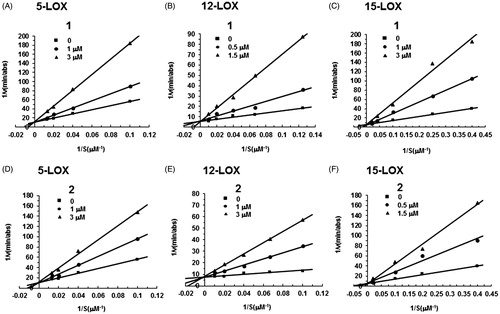
Compound 1 is a redox-active 5-LOX inhibitor
According to their molecular mode of action, 5-LOX inhibitors can be divided into three main types: redox-active compounds, iron-chelators and nonredox-type inhibitors. Enzymatic oxidation of AA by 5-LOX involves the generation of free radical intermediates and redox-active molecules can scavenge radicals and/or decrease the active site iron, and thus broke the catalytic redox-cycle of 5-LOXCitation33. Potential reducing activities of the several phenolic hydroxyl moieties in the 2-arylbenzo[b]furan structures may be one possible explanation for 5-LOX inhibition. To investigate the redox potential of these 2-arylbenzo[b]furans, we analyzed the radical scavenging properties of compound 1 in the well-recognized DPPH assay. Compound 1 reduced the DPPH radicals with an apparent 1:2 stoichiometry (). Consequently, these 2-arylbenzo[b]furan-based LOX inhibitors can be categorized into redox-active compounds.
Compound 1 potently inhibit LTB4 biosynthesis in neutrophils
Phospholipase A2 (PLA2) can catalyze the hydrolysis of the sn-2 position of membrane glycerophospholipids to liberate AA. After released from membranes, AA was first catalyzed by 5-LOX into the unstable epoxide intermediate LTA4, and subsequently hydrolyzed into LTB4Citation40. We then investigated whether compound 1 inhibits 5-LOX medicated LTB4 production in A23187-stimulated neutrophils, a well-established cell-based evaluation system to study the potential of direct 5-LOX inhibitors in physiologic environmentCitation41. Compound 1 was pre-incubated with neutrophils for 30 min, and then LTB4 formation was initiated by the addition of A23187. The concentration of LTB4 produced by neutrophils was determined by a commercial LTB4 EIA kit (Cayman Chemical). As shown in , compound 1 significantly reduced LTB4 biosynthesis in neutrophils in a dose-dependent manner, suggesting that compound 1 is capable of inhibiting 5-LOX in intact cells.
Figure 3. Effect of 1 on LTB4 generation in neutrophils. Isolated mouse neutrophils were pretreated with various concentrations of 1 for 30 min, then simulated with A23187 (10 μM) for another 30 min. LTB4 levels in the supernatant were determined by a commercial ELISA kit. NDGA (10 μM) was used as a positive control. All data are represent as mean ± SD. *p < 0.05, **p < 0.01, ***p < 0.001. p Values were obtained by the one-way ANOVA test.
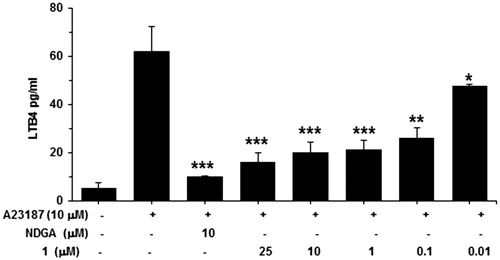
Compound 1 remarkably reduce fMLP induced neutrophils migration
We then examined the effects of compound 1 on neutrophils migration by a transwell assay. Upon the stimulation of a primary chemoattractant of neutrophil (fMLP), the number of migrated neutrophils in lower chamber was increased by more than two fold. The pretreatment of neutrophil with compound 1 significantly inhibited fMLP-induced directional migration of neutrophils (). Notably, compound 1 almost completely abrogated fMLP-induced neutrophil migration at a concentration of 10 μM. These data showed that compound 1 significantly suppressed neutrophil chemotaxis, and inhibition of 5-LOX may be relevant with the effect of compound 1 on neutrophil migration.
Figure 4. Effect of 1 on fMLP-induced neutrophils migration. Neutrophils isolated from the bone marrow of mouse were pretreated with various concentrations of 1 for 30 min and then simulated with fMLP (5 μM) for 37 °C for 1 h using a 96-well chemotaxis plate with 3 μm pore diameter. Migrated cells were collected and counted. NDGA (10 μM) was used as a positive control. All data are represented as mean ± SD. **p < 0.01, ***p < 0.001. p Values were obtained by the one-way ANOVA test.
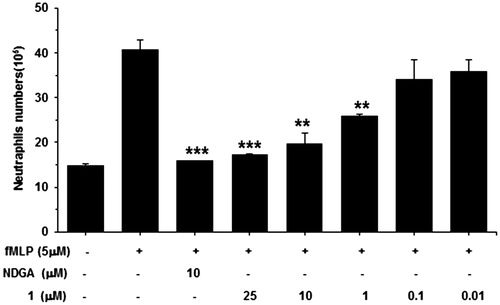
Effect of compound 1 on acetic acid-induced vascular permeability in mice
5-LOX-derived LT production has been shown to possess indisputable roles in inflammatory responses. For example, LTs have been shown to increase vascular permeability in a neutrophil-dependent manner via intracellular calcium mobilization and secretion of heparin-binding protein (HBP)Citation42. Interestingly, suppression of multiple LT production leads to decrease in leucocyte migration, exudation and decreased vascular permeability in an acetic acid-induced vascular permeability modelCitation43, indicating that targeting 5-LOX may have a potential therapeutic effect in inflammatory responses.
We then use an acetic acid-induced vascular permeability assay to evaluate the in vivo anti-inflammatory effect of 1. The extravasation of Evans blue from the plasma into the peritoneal cavity is a convenient assay to measure vascular permeability. As shown in , compound 1 showed a significant and dose-dependent effect against acute inflammation induced by acetic acid at the doses of 20 and 50 mg/kg, and the inhibition of dye leakage rates from the plasma into the peritoneal were 25.36% and 51.50%, respectively. As a positive control, NDGA (20 mg/kg, i.p.) generated a similar inhibition of dye leakage (55.65%) compared to 1 at a dose of 50 mg/kg. Collectively, these data indicated that compound 1 can effectively protect the vascular barrier integrity in vivo.
Conclusion
In summary, these natural and synthetic 2-arylbenzo[b]furan derivatives showed promising inhibitory potency against LOX enzyme activities in vitro. Among them, compound 1 showed the most effective inhibitory effect and moderate sub-type selectivity for 12-LOX. Besides, compound 1 significantly inhibited LTB4 biosynthesis in neutrophils, reduced neutrophils migration and protected vascular barrier from plasma leakage in an acetic acid-induced vascular permeability test. Our findings show that 1 might be an available agent by targeting LOXs for the treatment of inflammatory diseases, and this result might be a helpful guide for the development of more potent LOX inhibitors derived from natural products.
Declaration of interest
The authors declare no conflict of interest.
The stable-5-LOX plasmid was from Professor Marcia E. Newcomer (Louisiana State University). pCDNA3–12-LOX and pCDNA3–15-LOX were from by Professor Colin D. Funk (Queen’s University, Canada). Financial support of this research was provided by the National Natural Science Foundation of China [Grants 21222211, 21372001, 91313303, 81402482], the Program for New Century Excellent Talents in University [Grant NCET-12–0853], Shanghai Committee of Science and Technology [Grant 11DZ2260600 and 14ZR1411100], China Postdoctoral Science Foundation grant [2014M551361 and 2015T80415], “Shu Guang” project supported by Shanghai Municipal Education Commission and Shanghai Education Development Foundation [Grant 14SG28], and the Fundamental Research Funds for the Central Universities is gratefully acknowledged.
Supplementary material available online
IENZ_1220376_Supplementary_Figure_1.pdf
Download PDF (42.8 KB)References
- Funk CD, Cyrus T. 12/15-Lipoxygenase, oxidative modification of LDL and atherogenesis. Trends Cardiovasc Med 2001;11:116–24
- Kuhn H, Thiele BJ. The diversity of the lipoxygenase family. Many sequence data but little information on biological significance. FEBS Lett 1999;449:7–11
- Brash AR. Lipoxygenases: occurrence, Ffunctions, catalysis, and acquisition of substrate. J Biol Chem 1999;274:23679–82
- Mandal AK, Skoch J, Bacskai BJ, et al. The membrane organization of leukotriene synthesis. Proc Natl Acad Sci USA 2004;101:6587–92
- Fabre JE, Goulet JL, Riche E, et al. Transcellular biosynthesis contributes to the production of leukotrienes during inflammatory responses in vivo. J Clin Invest 2002;109:1373–80
- Charlier C, Michaux C. Dual inhibition of cyclooxygenase-2 (COX-2) and 5-lipoxygenase (5-LOX) as a new strategy to provide safer non-steroidal anti-inflammatory drugs. Eur J Med Chem 2003;38:645–59
- Harizi H, Corcuff JB, Gualde N. Arachidonic acid-derived eicosanoids: roles in biology and immunopathology. Trends Mol Med 2008;14:461–9
- Nakamura M, Shimizu T. Leukotriene receptors. Chem Rev 2011;111:6231–98
- Dobrian AD, Lieb DC, Cole BK, et al. Functional and pathological roles of the 12- and 15-lipoxygenases. Prog Lipid Res 2011;50:115–31
- Sadeghian H, Jabbari A. 15-Lipoxygenase inhibitors: a patent review. Expert Opin Ther Pat 2016;26:65–88
- Lawrence T, Willoughby DA, Gilroy DW. Anti-inflammatory lipid mediators and insights into the resolution of inflammation. Nat Rev Immunol 2002;2:787–95
- Pergola C, Werz O. 5-Lipoxygenase inhibitors: a review of recent developments and patents. Expert Opin Ther Pat 2010;20:355–75
- Joshi YB, Giannopoulos PF, Praticò D. The 12/15-lipoxygenase as an emerging therapeutic target for Alzheimer's disease. Trends Pharmacol Sci 2015;36:181–6
- Funk CD. Prostaglandins and leukotrienes: advances in eicosanoid biology. Science 2001;294:1871–5
- Chan FL, Choi HL, Chen ZY, et al. Induction of apoptosis in prostate cancer cell lines by a flavonoid, baicalin. Cancer Lett 2000;160:219–28
- Chen CH, Huang LL, Huang CC, et al. Baicalein, a novel apoptotic agent for hepatoma cell lines: a potential medicine for hepatoma. Nutr Cancer 2000;38:287–95
- Nie D, Tang K, Diglio C, Honn KV. Eicosanoid regulation of angiogenesis: role of endothelial arachidonate 12-lipoxygenase. Blood 2000;95:2304–11
- Weinstein DS, Wen L, Ngu K, et al. Discovery of selective imidazole-based inhibitors of mammalian 15-lipoxygenase: Highly potent against human enzyme within a cellular environment. Bioorg Med Chem Lett 2007;17:5115–20
- Ganesha R, Victor K, Ajit J, et al. Discovery of potent and selective inhibitors of human reticulocyte 15-lipoxygenase-1. J Med Chem 2010;53:7392–404
- Weinstein DS, Liu W ,Gu Z, et al. Tryptamine and homotryptamine-based sulfonamides as potent and selective inhibitors of 15-lipoxygenase. Bioorg Med Chem Lett 2005;15:1435–40
- Jagtap UB, Bapat VA. Artocarpus: a review of its traditional uses, phytochemistry and pharmacology. J Ethnopharmacol 2010;129:142–66
- Hakim EH, Achmad SA, Juliawaty LD, et al. Prenylated flavonoids and related compounds of the Indonesian Artocarpus (Moraceae). J Nat Med 2006;60:161–84
- Takasugi M, Nagao S, Ueno S, et al. Moracin C and D, new phytoalexins from diseased mulberry. Chem Lett 1978;7:1239–40
- Katritzky AR, Rees CW, Scriven EFV. Comprehensive heterocyclic chemistry II: a review of the literature, 1982–1995: the structure, reactions, synthesis, and uses of heterocyclic compounds. Pergamon: Oxford; 1996
- Navarro E, Alonso SJ, Trujillo J, et al. General behavior, toxicity, and cytotoxic activity of elenoside, a lignan from Justicia hyssopifolia. J Nat Prod 2001;64:134–5
- Day S, Chiu N, Tsao L, et al. New lignan glycosides with potent antiinflammatory effect, isolated from Justicia ciliata. J Nat Prod 2000;63:1560–2
- Craigo J, Callahan M, Huang RC, Delucia AL. Inhibition of human papillomavirus type 16 gene expression by nordihydroguaiaretic acid plant lignan derivatives. Antiviral Res 2000;47:19–28
- Silva DHS, Pereira FC, Zanoni MVB, Yoshida M. Lipophyllic antioxidants from Iryanthera juruensis fruits. Phytochemistry 2001;57:437–42
- Wu D, Mei H, Tan P, et al. Total synthesis of the 2-arylbenzo[b]furan-containing natural products from Artocarpus. Tetrahedron Lett 2015;56:4383–7
- Lu W, Zhao X, Xu Z, et al. Development of a new colorimetric assay for lipoxygenase activity. Anal Biochem 2013;441:162–8
- Zhao X, Lu W, Song C, Huang J. Detection of mammalian 5-lipoxygenase activity using the fluorescent probe dihydrorhodamine 1,2,3. Eur J Lipid Sci Tech 2014;116:119–25
- Lu W, Xue Z, Zou S, Jin H. A fluorimetric assay for human reticulocyte 15-lipoxygenase-1 activity. Anal Biochem 2012;426:66–8
- Pergola C, Jazzar B, Rossi A, et al. Cinnamyl-3,4-dihydroxy-α-cyanocinnamate is a potent inhibitor of 5-lipoxygenase. J Pharmacol Exp Ther 2011;338:205–13
- Afonso PV, Janka-Junttila M, Lee YJ, et al. LTB 4 is a signal-relay molecule during neutrophil chemotaxis. Dev Cell 2012;22:1079–91
- Boxio R, Bossenmeyer-Pourié C, Steinckwich N, et al. Mouse bone marrow contains large numbers of functionally competent neutrophils. J Leukoc Biol 2004;75:604–11
- Helgadottir A, Manolescu A, Thorleifsson G, et al. The gene encoding 5-lipoxygenase activating protein confers risk of myocardial infarction and stroke. Nat Genet 2004;36:233–9
- Whittle B. The use of changes in capillary permeability in mice to distinguish between narcotic and nonnarcotic analgesics. Br J Pharmacol Chemother 1964;22:246–53
- Koo HJ, Lim KH, Jung HJ, Park EH. Anti-inflammatory evaluation of gardenia extract, geniposide and genipin. J Ethnopharmacol 2006;103:496–500
- Morebise O, Fafunso MA, Makinde JM, et al. Antiinflammatory property of the leaves of Gongronema latifolium. Phytother Res 2002;16:75–7
- Haeggström JZ, Funk CD. Lipoxygenase and leukotriene pathways: biochemistry, biology, and roles in disease. Chem Rev 2011;111:5866–98
- Schaible AM, Traber H, Temml V, et al. Potent inhibition of human 5-lipoxygenase and microsomal prostaglandin E(2) synthase-1 by the anti-carcinogenic and anti-inflammatory agent embelin. Biochem Pharmacol 2013;86:476–86
- Antonio DG, Ellinor K, Min W, et al, Leukotriene B4-induced changes in vascular permeability are mediated by neutrophil release of heparin-binding protein (HBP/CAP37/azurocidin). FASEB J 2009;23:1750–7
- Albeena N, Malik AH, Mohammed Afzal Z. Atropa acuminata Royle Ex Lindl. blunts production of pro-inflammatory mediators eicosanoids, leukotrienes, cytokines in vitro and in vivo models of acute inflammatory responses. J Ethnopharmacol 2015;180:353–7

